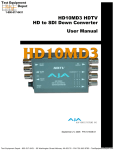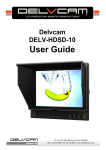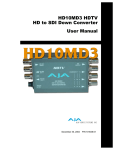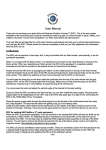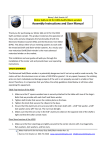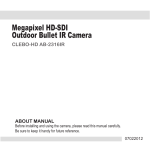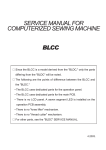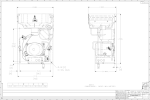Download Installation Instructions – BMW
Transcript
Installation Instructions – BMW Thank you for purchasing this quality ACT product. ACT has a long racing heritage supporting countless racers and series champions in many forms of racing. Now you can let ACT’s experience and expertise give you the same winning results. The ongoing challenge to win puts a constant demand for improved and higher performance ACT products. Constant challenges and continual improvement are driving forces at ACT. Since ACT products are racing bred and performance oriented some tradeoffs may be expected. If for any reason ACT does not meet your challenge or expectations, let us know so ACT products can continue to improve. Consult our catalog, website, or contact us directly if you have any questions, comments or concerns. Special Features & Benefits: This kit is designed to replace the factory pressure plate, clutch disc, release bearing and flywheel with the components listed below. With the exception of the factory pilot and release bearings, the ACT pressure plate, ACT clutch disc and ACT flywheel must be used together and will not work with any of the factory components. For quicker acceleration and faster shifting, the weight of our flywheel has been considerably reduced. Additional Notes or Warnings: Attention: The following instructions are meant as a supplement to the factory clutch installation processes and are not intended as a complete installation instruction. Break in: For racing purposes, break in period for ACT puck type Race Discs can be accelerated by performing several hard slips in high gear. Allow the clutch to cool for about 10 minutes between these slips to prevent overheating. The purpose is to lap the surfaces together under controlled load until there is complete surface contact and therefore full torque capacity is achieved. Warning: This is not a preferred break‐in method. As with any accelerated technique, damage may result unless performed correctly with a skilled operator. Gear noise: Due to the performance nature of the ACT single mass flywheel designed to replace the stock dual mass flywheel, increased gear noise is expected. The ACT spring center disc will reduce gear noise, but not eliminated it. A solid center disc is not recommended except for racing applications due to excessive gear noise. Please read the enclosed Gear Rattle Tech Bulletin for more information. Flywheel resurfacing: When needed, all ACT flywheels can be resurfaced by a qualified automotive machine shop. Be sure to retain original flywheel step. Replacement parts: All replacement parts are available separately. Further information: For a complete list of technical bulletins, please visit our website at www.advancedclutch.com. Advanced Clutch Technology 206 East Avenue K‐4 Lancaster, CA 93535 (661) 940‐7555, Fax: (661) 940‐7541 www.advancedclutch.com [email protected] Failure to follow the vehicle manufacturer’s installation procedures and specifications as the primary source of information and ACT’s installation instructions as a secondary source may lead to serious injury, death or clutch failure. Installation should only be performed by an experienced knowledgeable mechanic. 1 Applications: Make Model Year(s) Engine BMW BMW BMW BMW BMW BMW BMW BMW BMW BMW E46 M3 E34 525i E36 323¹ E36 325¹ E36 328 E46 323 E46 325 E46 328 E46 330 Z3¹ 01‐06 92‐95 92‐99 92‐99 92‐99 99‐05 99‐05 99‐05 99‐05 97‐02 3.2 All All All All All All All All 2.5, 2.3, 1.9, 1.8 Vehicle ‐ Application Details: ¹Recommend upgrading to E36 M3 slave cylinder. Parts / Kit Components List: Kit BM4‐HDSS BM4‐HDSD BM4‐HDR4 BM4‐HDG4 BM4‐HDR6 BM4‐HDG6 BM5‐HDSS BM5‐HDSD BM5‐HDR4 BM5‐HDG4 BM5‐HDR6 BM5‐HDG6 BM6‐HDG4 BM6‐HDG6 BM6‐HDR4 BM6‐HDR6 BM6‐HDSS BM7‐HDG4 BM7‐HDG6 BM7‐HDR4 BM7‐HDR6 BM7‐HDSS Pressure Plate Disc Release Bearing Pilot Bushing Align. Tool Flywheel B014 B014 B014 B014 B014 B014 B014 B014 B014 B014 B014 B014 B014 B014 B014 B014 B014 B014 B014 B014 B014 B014 3000805 3000804 4240029 4240529 6240029 6240529 3000805 3000804 4240029 4240529 6240029 6240529 4240502 6240502 4240502 6240002 3000801 4240502 6240502 4240002 6240002 3000801 RB1401 RB1401 RB1401 RB1401 RB1401 RB1401 RB1401 RB1401 RB1401 RB1401 RB1401 RB1401 RB172 RB172 RB172 RB172 RB172 RB172 RB172 RB172 RB172 RB172 PB1002 PB1002 PB1002 PB1002 PB1002 PB1002 PB1002 PB1002 PB1002 PB1002 PB1002 PB1002 PB1002 PB1002 PB1002 PB1002 PB1002 PB1002 PB1002 PB1002 PB1002 PB1002 ATB01 ATB01 ATB01 ATB01 ATB01 ATB01 ATB01 ATB01 ATB01 ATB01 ATB01 ATB01 ATGM010 ATGM010 ATGM010 ATGM010 ATGM010 ATGM010 ATGM010 ATGM010 ATGM010 ATGM010 600260 600260 600260 600260 600260 600260 600265 600265 600265 600265 600265 600265 600260 600260 600260 600260 600260 600265 600265 600265 600265 600265 2 Installation Instructions: 1. Inspect the old clutch and operating system to confirm that everything is in proper working condition, including the hydraulic system, bearing free travel and that there is no oil leaks on the rear main and transmission seals. Inspect releaser guide tube, release fork, pivot stud, and bushings for wear. Any of these problems must be corrected before installing your new clutch. 2. Remove all stock components as recommended by vehicle manufacturer. 3. Clean the flywheel and pressure plate surfaces with solvent or detergent. Clutch slippage or chatter can be caused by a dirty or oily surface. Also clean flywheel and crankshaft mating surfaces. Install the new flywheel and bolts with medium thread locker and torque to the manufacturers suggested torque specification found in your service manual. Lightly grease the splines of the disc and slide the new disc on the input shaft to insure fit and smooth travel, and wipe off any excess grease. Install new pilot bearing into crankshaft. 4. Use the provided alignment tool to center the disc against the flywheel after verifying that the “flywheel side” sticker found on one side of the disc, is against the flywheel and that the disc is correctly installed. Next locate the pressure plate over the disc and rotate until it locates on the flywheel dowels. Manually tighten the six pressure plate bolts using a star or diagonal pattern to evenly pull the pressure plate up tight against the flywheel. The new 8mm 10.9 grade fasteners can be tightened to 30ft lbs. The use of high temperature thread locking compound is recommended for performance applications. 5. Lightly lubricate the new release bearing inside diameter and the mating surfaces between the fork and releaser and wipe off excess grease. Lubricate the clutch linkage and install as recommended by vehicle manufacturer. 6. Make sure all bell housing dowels are in correct position and tighten bell housing bolts. Any misalignment will result in premature clutch failure. Correctly support the transmission during installation, neglecting to do so may cause clutch damage and premature failure. 7. Adjust the clutch release system by following the manufacturer’s procedures and specifications if applicable. Recommended break in for all ACT clutches is 200‐300 miles of mild street driving. Avoid driving habits that would allow excessive slipping or overheating of the clutch. 3 Gear Rattle Tech Bulletin Gear rattle can be explained as an audible noise transmitted from the impacts between the transmission gear teeth caused by the torsional vibrations of the engine. Torsional vibration (momentary angular acceleration) occurs on all engines. The separation and resulting impact of the gear teeth are caused by the engine’s torsional vibrations when passed from the engine through the clutch and to finally to the transmission gears. Gear rattle is usually louder as it resonates at a specific rpm or under certain conditions. Consequently there are a several common types such as idle mode, acceleration mode, deceleration mode, or coast rattle. Gear rattle is not to be confused with clutch chatter or out‐of‐balance vibrations; both of which are conditions mostly felt and not as much heard. Traditionally, automakers have dampened torsional vibrations by using a heavy single mass flywheel and a clutch disc with a sprung center design. But in recent years many now use a dual mass flywheel to silence the gear rattle in the transmission. In most applications the dual mass flywheel is so effective at dampening out torsional vibrations that a solid center disc can be used. However the factory uses both a dual mass flywheel and spring center disc to dampen out torsional vibration and gear noise. When switching from a dual mass flywheel to a solid flywheel like an ACT Streetlite or Prolite, a spring center clutch disc is recommended for street use to dampen the torsional vibrations and reduce gear rattle. In some racing applications a solid center disc may be used, but since all effective torsional dampening has been eliminated, excessive gear noise will result. There are some advantages and disadvantages to a dual mass flywheel design. There are also many other factors that can contribute to gear noise. Due to the complexity of the subject, this is not intended as a complete discussion. To learn more about clutch and flywheel facts, consult our website at www.advancedclutch.com. You can also call or email our helpful staff. Find out how you can sign up for our email newsletter which will include in depth clutch and flywheel design articles covering topics such as torsional vibration and gear noise. 4







